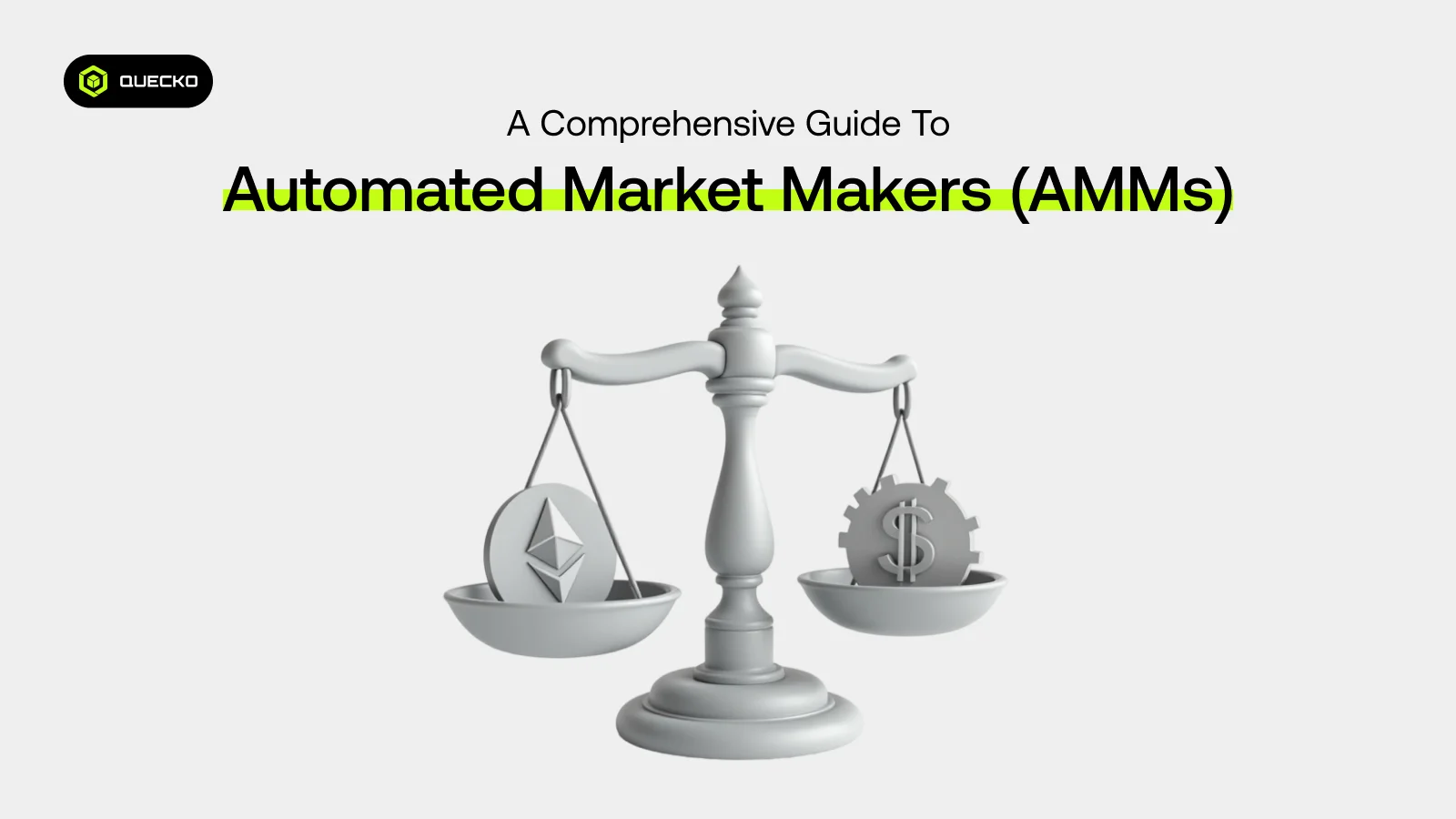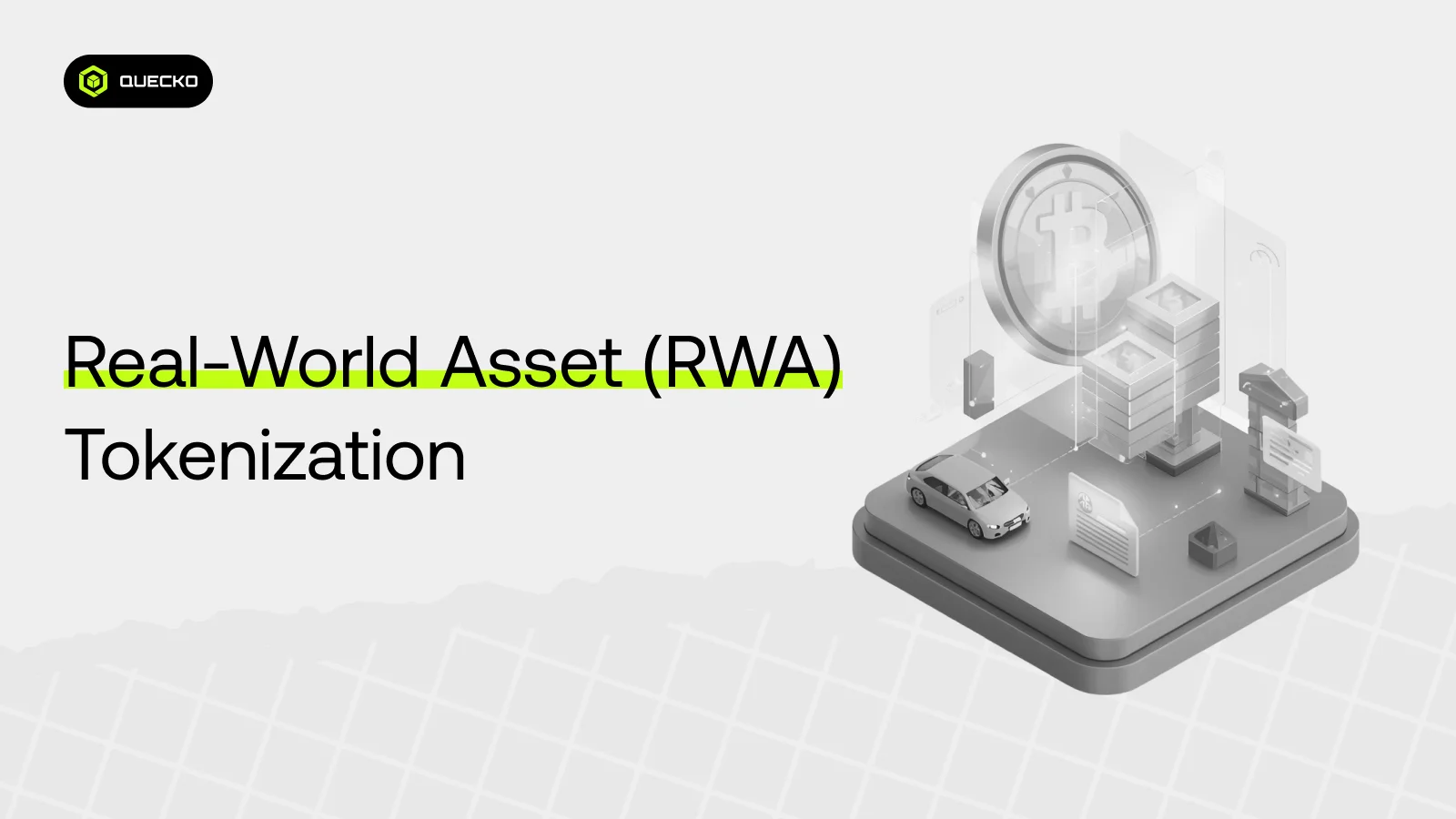A Comprehensive Guide to Automated Market Makers (AMMs) and How They Work
Discover how AMMs revolutionize DeFi with liquidity, efficient trading, and seamless transactions.

In the rapidly expanding world of decentralized finance (DeFi), Automated Market Makers (AMMs) have emerged as a revolutionary force, transforming how users trade crypto assets without the need for traditional intermediaries. Unlike centralized exchanges, which rely on order books to match buyers and sellers, AMMs utilize mathematical algorithms and smart contracts to enable seamless, decentralized, and permissionless trading of digital assets.
This blog will provide a detailed explanation of what AMMs are, how they work, and their significance in the DeFi ecosystem.
What is an Automated Market Maker (AMM)?
An Automated Market Maker (AMM) is a type of decentralized exchange (DEX) protocol that plays a crucial role in modern crypto exchange platforms. Unlike centralized exchanges, which rely on order books to match buyers and sellers, AMMs use mathematical formulas and smart contracts to establish market prices and facilitate the trading process in a decentralized manner.
Instead of direct peer-to-peer transactions, AMMs create liquidity pools where users can trade assets directly with the pool, eliminating the need for intermediaries. These pools contain various trading pairs, allowing users to swap different crypto assets seamlessly. The asset price in an AMM is determined algorithmically based on the ratio of tokens within the liquidity pool, ensuring continuous liquidity for traders even in volatile markets.
How Do AMMs Work?
AMMs play a crucial role in the cryptocurrency market, revolutionizing decentralized trading by eliminating the need for traditional exchanges and traditional order books. Instead, they rely on mathematical formulas and liquidity pools to facilitate seamless trading of digital assets in a decentralized exchange environment.
1. Liquidity Pools
At the core of AMMs is the concept of liquidity pools, which function as smart contracts holding reserves of two or more tokens. These pools enable traders to exchange assets without requiring a direct buyer-seller match, ensuring uninterrupted trading activities in the crypto exchange space.
For instance, a liquidity pool containing ETH and DAI allows users to swap between these two assets based on their token ratio rather than relying on order books seen in traditional exchanges.
Liquidity providers (LPs) deposit an equal value of both tokens into the pool, earning LP tokens, which represent their share of the pool’s assets. These LP tokens can be redeemed for the underlying assets anytime, along with a portion of the trading fees generated by users who participate in swaps.
2. Constant Product Market Maker Formula
The most common pricing mechanism in AMMs is the Constant Product Market Maker formula, which was popularized by Uniswap. The formula follows:
$$x \times y = k$$
Where:
- x is the quantity of the first token in the pool.
- y is the quantity of the second token in the pool.
- k is a constant value that remains unchanged during trades.
This formula ensures that as the asset ratio of tokens fluctuates due to trading activities, their token prices adjust automatically, maintaining liquidity while preventing market manipulation.
Example:
Suppose a liquidity pool contains 100 ETH and 10,000 DAI.
If a trader wants to buy 1 ETH from the pool, they must deposit enough DAI to ensure that k remains constant.
Thus, the trader would need to deposit approximately 101.01 DAI to receive 1 ETH, resulting in an exchange rate of 101.01 DAI/ETH at that moment.
3. Price Slippage
A critical aspect of AMMs is price slippage, which occurs when the price of an asset changes between order initiation and execution. Since AMMs rely on liquidity pools rather than traditional order books, the size of a trade relative to the pool directly impacts the token prices.
In volatile markets, larger trades can cause significant price shifts, leading to higher slippage. Traders mitigate slippage by:
- Splitting large trades into smaller transactions.
- Using AMMs with deep liquidity pools to minimize exchange rate variations.
4. Impermanent Loss
Impermanent loss is a potential risk faced by liquidity providers when the price of tokens fluctuates after depositing assets in a pool. If the market price of a token changes significantly compared to when it was deposited, LPs might receive a lower value upon withdrawal than if they had simply held the tokens.
Example:
If an LP deposits 1 ETH and 100 DAI into a pool when ETH is priced at 100 DAI, they expect their share to remain balanced. However, if ETH rises to 200 DAI, the pool automatically rebalances, altering the LP’s asset distribution.
While impermanent loss can reverse if the crypto market stabilizes, prolonged price divergence may lead to permanent losses, making it an important factor for LPs to consider when adding liquidity to AMMs.
5. Trading Fees & Rewards
AMMs generate revenue through trading fees, typically a small percentage (e.g., 0.3%) of each trade. These fees are distributed to LPs as an incentive for contributing liquidity to AMMs, helping offset potential losses and providing passive income opportunities.
Potential Risks in AMMs
Despite their advantages, AMMs also come with potential risks, including:
- Impermanent loss due to price fluctuations.
- Smart contract vulnerabilities that may expose liquidity pools to hacks.
- Market volatility, leading to unpredictable token prices and slippage.
- Dependence on internet connections, as traders rely on real-time access to protocols for executing transactions in decentralized exchanges.
Types of AMMs
While the Constant Product Market Maker remains the most widely recognized type of Automated Market Maker (AMM), various models have been developed to suit different market conditions and price volatility levels. Each type uses a common formula designed to maintain liquidity and ensure continuous trading while mitigating risks associated with decentralized exchanges.
1. Constant Sum Market Maker
The Constant Sum Market Maker is primarily used for stablecoin pairs, where the prices of assets are expected to remain relatively stable.
This model operates under the assumption that the sum of assets remains unchanged, but it has a significant drawback: if the ratio of assets deviates too much from expected levels, liquidity can be depleted, making it vulnerable in highly volatile markets. Due to this, it is rarely implemented in large-scale crypto exchanges.
2. Constant Mean Market Maker
The Constant Mean Market Maker is a generalization of the constant product formula and supports pools with more than two tokens.
This model assigns different weights (n, m, etc.) to the tokens in the pool, creating a flexible structure for liquidity provision. It is widely used in protocols like Balancer, which allow for customizable weight distribution and pairs of tokens beyond the traditional two-asset system.
By incorporating additional tokens, this type of AMM ensures greater stability, making it ideal for diverse asset management strategies. It enables more sophisticated decentralized trading and accommodates dynamic portfolio adjustments.
3. Hybrid AMMs
Some AMMs integrate multiple mechanisms to optimize liquidity management. For example, Curve Finance employs a hybrid formula that combines the Constant Product Market Maker and Constant Sum Market Maker models.
This unique structure minimizes price volatility and exchange rate fluctuations, making it particularly useful for stablecoin trading. By adjusting the asset ratio, Hybrid AMMs help reduce investment risks associated with liquidity pool inefficiencies.
4. Dynamic Automated Market Makers (DAMMs)
A Dynamic Automated Market Maker (DAMM) adjusts its pricing algorithm in response to market conditions and demand fluctuations. Unlike fixed models, DAMMs adapt to real-time trading activities, optimizing liquidity distribution and reducing impermanent loss.
DAMMs can incorporate synthetic assets, allowing traders to interact with derivative markets without relying on traditional financial intermediaries.
Security Considerations
Despite their advantages, AMMs face potential threats, including vulnerabilities posed by malicious actors. Smart contract exploits, price manipulation, and flash loan attacks can disrupt liquidity pools, leading to substantial losses. Understanding these risks is critical for traders and liquidity providers engaging in crypto exchange platforms.
Advantages of AMMs
Automated Market Makers (AMMs) have revolutionized crypto trading by enabling seamless transactions without the need for intermediaries. Their decentralized model has significantly improved liquidity management and enhanced market efficiency within the financial ecosystem. Here’s a closer look at their key advantages:
1. Decentralization
AMMs operate on blockchain networks and are governed by smart contracts, eliminating the need for centralized intermediaries. This decentralized nature reduces the risk of censorship, enhances security, and provides users full control over their funds. Additionally, decentralized AMMs contribute to a more transparent financial ecosystem, ensuring equal opportunities for all participants.
2. Continuous Liquidity
Unlike traditional exchanges, which rely on order books, AMMs ensure continuous trading through liquidity pools. This structure allows users to trade assets even in illiquid markets, addressing liquidity issues that often arise in centralized platforms. Whether trading stablecoins, major cryptocurrencies, or a range of assets, AMMs provide accessible liquidity regardless of trading volume.
3. Permissionless Access
One of the defining features of AMMs is permissionless access—anyone can participate as a liquidity provider or trader without requiring approval from a central authority. By facilitating seamless crypto trading, AMMs promote financial inclusion and empower users worldwide to engage in decentralized finance (DeFi) markets.
4. Innovation in DeFi
AMMs have fueled several groundbreaking innovations, including yield farming, liquidity mining, and decentralized derivatives. Additionally, platforms like Constant Product AMMs have introduced advanced trading mechanisms that automatically rebalance token holdings based on the balance of assets in liquidity pools. This innovation expands investment opportunities and enhances trading strategies.
5. Enhanced Market Efficiency
By eliminating the need for intermediaries and order books, AMMs improve market efficiency by allowing instant swaps between token pairs. The liquidity of the pool plays a crucial role in determining token prices, ensuring smoother transactions and reducing slippage during high-demand periods.
6. Mitigating Liquidity Risks for Traders
While liquidity providers may face loss for liquidity providers due to price fluctuations (impermanent loss), AMMs help mitigate risk through reward incentives. Trading fees collected within the pools help compensate liquidity providers for their participation, making it a viable strategy despite market fluctuations.
7. Optimized Trading Experience
AMMs simplify the trading experience, enabling users to trade effortlessly without navigating complex order book mechanisms. Traders benefit from automated price adjustments based on the ratio of assets in the pool, ensuring a more user-friendly and predictable exchange process.
By addressing liquidity issues, promoting innovation, and enhancing market efficiency, AMMs continue to shape the future of decentralized finance. As their adoption expands, AMMs will remain an essential component of crypto trading, fostering a more accessible and equitable financial ecosystem for users worldwide.
Challenges and Limitations of AMMs
While AMMs play a critical role in shaping the financial landscape of decentralized finance (DeFi), they also come with inherent risks that traders and liquidity providers must navigate. Understanding these challenges is essential for optimizing an efficient trading experience and mitigating potential downsides.
1. Impermanent Loss
As previously discussed, impermanent loss poses a significant challenge for liquidity providers. When the trade size of a particular asset alters the ratio of assets in a pool, LPs may suffer losses compared to simply holding their tokens. This risk affects the long-term viability of AMMs, especially for pools with volatile assets. Liquidity providers must assess their risk tolerance before depositing funds into AMM liquidity pools.
2. Slippage & Price Volatility
Large trades often result in price slippage, especially in pools with low liquidity. Since AMMs determine prices algorithmically rather than through traditional order books, a significant trade can cause drastic price changes. This instability reduces market efficiency and leads to unfavorable pricing conditions for traders. Arbitrage traders play a role in balancing price discrepancies, but slippage remains a major limitation, particularly in multi-asset pools.
3. Smart Contract Risks & Mathematical Vulnerabilities
AMMs are built using blockchain technology, which relies on smart contracts to execute transactions. While these smart contracts eliminate human intermediaries, they are susceptible to mathematical risks, coding errors, and potential exploits by malicious actors. A single bug or vulnerability can result in substantial financial losses, making security audits a key component in the development of AMM protocols.
4. High Transaction Costs
Trading on AMMs involves transaction costs, primarily in the form of network fees. During periods of congestion, blockchain networks like Ethereum experience spikes in gas fees, increasing the cost of executing trades. For smaller transactions, high fees can make AMMs less of an attractive option, especially when compared to centralized exchanges with lower operational expenses.
5. Regulatory Uncertainty
The DeFi space is still evolving, and global regulators are working to establish frameworks for decentralized exchanges and AMMs. The uncertain legal status of AMMs could impact adoption rates and investor confidence. Governments may introduce restrictions that alter how AMMs function, making compliance an ongoing concern for developers and users alike.
6. User Interface Complexity
While AMMs enable permissionless access, some users find their user interface difficult to navigate, especially when dealing with advanced features such as hybrid models that adjust liquidity dynamically. Simplifying access while maintaining security remains a critical focus for improving adoption.
Popular AMM Protocols
Several Automated Market Makers (AMMs) have established themselves as backbones of AMMs, handling billions of dollars in trading volume while reshaping market dynamics in decentralized exchanges. Here are some of the most influential AMM protocols:
1. Uniswap
Uniswap is the most widely recognized AMM, pioneering the Constant Product Market Maker formula and revolutionizing price determination in DeFi. Operating on the Ethereum blockchain, it allows users to trade native tokens like ERC-20 assets while offering liquidity strategies that optimize capital allocation. Uniswap remains central to the potential returns generated by liquidity providers.
2. SushiSwap
SushiSwap emerged as a fork of Uniswap, introducing governance through the SUSHI token and adding features like yield farming. It has expanded across multiple blockchain networks, lowering barriers to entry for new traders. By optimizing liquidity strategies, SushiSwap enhances the efficiency of its pools, ensuring price stability for traders.
3. Balancer
Balancer offers multi-token pools with customizable price ranges, providing an alternative structure for liquidity management. It allows users to add assets to liquidity pools with varied weight distributions, promoting fair prices in arbitrage trading scenarios. This flexibility makes Balancer a popular choice for index funds and complex asset allocations.
4. Curve Finance
Curve Finance is a specialized AMM designed for stablecoin swaps, using a hybrid model to minimize price volatility. By implementing adaptive liquidity mechanisms, Curve ensures fair prices and actual price accuracy, making it an essential tool for efficient arbitrage trading.
5. PancakeSwap
Built on Binance Smart Chain (BSC), PancakeSwap provides infinite liquidity with lower transaction fees compared to Ethereum-based AMMs. It supports a wide array of native tokens and offers an intuitive user interface for traders seeking seamless transactions.
The Future of AMMs
AMMs have already transformed DeFi, but further innovations aim to enhance their effectiveness:
1. Improved Capital Efficiency
Traditional AMMs require vast amounts of liquidity to minimize slippage, which can be inefficient. Concentrated liquidity models, such as Uniswap V3, allow LPs to allocate liquidity within specific price ranges, optimizing current market price alignment and reducing capital waste.
2. Cross-Chain AMMs
The evolution of decentralized exchanges is moving toward cross-chain AMMs, enabling trading across different blockchain networks. This will enhance market dynamics and provide better access to real-world assets.
3. Dynamic Fee Structures
Some AMMs are exploring dynamic fee adjustments based on market dynamics, ensuring price stability while optimizing prices of tokens to improve trader incentives.
4. Integration with Traditional Finance
As DeFi expands, AMMs could merge with traditional financial systems, bridging arbitrage trading between centralized and decentralized markets. This integration will help attract new participants and ensure fair prices for users in both financial sectors.
AMMs continue to push boundaries, redefining crypto trading with enhanced liquidity strategies, efficient price determination, and adaptive trading mechanisms. Their role in shaping decentralized finance will only grow, making them a cornerstone of future financial innovations
Conclusion
Automated Market Makers (AMMs) have fundamentally transformed the way assets are traded in the blockchain ecosystem, eliminating counterparty risk by replacing traditional order books with liquidity pools and self-executing contracts. By leveraging advanced algorithms, AMMs ensure faster transaction times, continuous liquidity, and seamless cross-chain compatibility, making them a crucial component of decentralized finance (DeFi).
Despite challenges such as impermanent loss and price slippage, AMMs remain an innovative solution for market participants, enabling traders to maximize their return on investment without relying on centralized intermediaries. As DeFi grows, new AMM designs will incorporate improved risk management strategies, optimizing liquidity pools while reducing financial exposure.
Looking ahead, AMMs will evolve to integrate more key features and additional features, enhancing financial services through multi-asset pools and better market efficiency. These changes will attract experienced traders, who may seek consulting services for specialized strategies in a complex landscape. Understanding AMMs is not only beneficial for liquidity providers but is also essential for anyone engaging with decentralized markets in the modern financial era.
Date
7 months agoShare on
Related Blogs

Real-World Asset (RWA) tokenization
6 hours ago

Gamified DeFi: How Play-to-Earn Models Are Reshaping User Engagement
5 days ago

How Blockchain Is Disrupting Traditional Banking Systems
16 days ago

AI-Powered Smart Contract Wallets The Future of User-Friendly Blockchain UX
21 days ago








